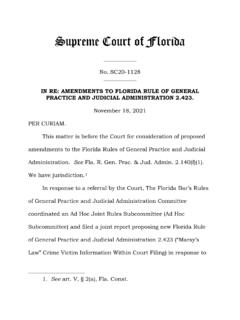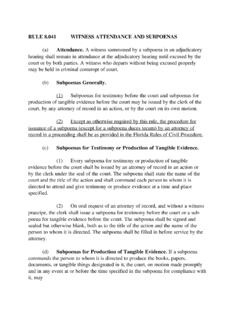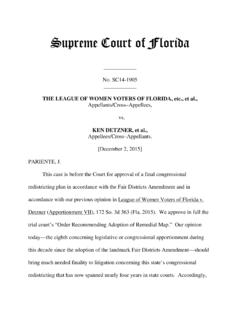Transcription of Supreme Court of Florida
1 Supreme Court of Florida _____. No. SC22-131. _____. IN RE: SENATE JOINT RESOLUTION OF LEGISLATIVE. APPORTIONMENT 100. March 3, 2022. MU IZ, J. The Florida Constitution requires the Legislature to reapportion our state into House and Senate districts after each decennial census. The Legislature did so this year by adopting Senate Joint Resolution 100 on February 3, 2022. Then, as the constitution commands, the Attorney General initiated this original proceeding for a declaratory judgment to determine the validity of the apportionment. 1 In what follows, we will explain our conclusion that the House and Senate apportionment in Senate Joint Resolution 100 is valid. 1. We have jurisdiction. Art III, 16(c), Fla. Const. The constitution gives us 30 days from the Attorney General's February 9, 2022, filing to enter our judgment. Id. I. This case comes to us in an unusual posture. The constitution requires our Court to hear from adversary interests.
2 On the validity of the Legislature's apportionment. Art. III, 16(c). And ordinarily our role in this proceeding would be to adjudicate specific challenges to the joint resolution. See In re Senate Joint Resolution of Legislative Apportionment 1176 (Apportionment I), 83 So. 3d 597, 601 (Fla. 2012) ( Before 1968, there was no process by which challengers to the Legislature's apportionment plans could seek direct and immediate review of the apportionment plans by the Supreme Court of Florida . ). But, for the first time since the voters adopted the existing procedural framework for judicial review of apportionment in 1968, no one appeared to oppose the Legislature's plans. Even without a challenging party, however, the constitution requires us to enter a judgment determining the validity of the apportionment. Art. III, 16(c). We undertake that task mindful of a few foundational principles. First, the joint resolution of apportionment enjoys a presumption of validity.
3 Apportionment I, 83 So. 3d at 606. Second, and relatedly, it is not the Legislature's -2- burden to prove the validity of the apportionment. In a typical review proceeding under article III, section 16(c), [o]pponents of [an] apportionment plan bear the burden of establishing a constitutional violation. In re Senate Joint Resolution of Legislative Apportionment 2-B (Apportionment II), 89 So. 3d 872, 881 (Fla. 2012). Third, although the Legislature must exercise its discretion within the bounds set by the constitution, legislative reapportionment is primarily a matter for legislative consideration and determination. In re Apportionment Law Senate Joint Resolution No. 1305, 1972 Regular Session, 263 So. 2d 797, 799. (Fla. 1972). Our Court 's duty under article III, section 16(c) is thus to enforce any discretion-limiting standards embodied in the constitutional text without curtailing the substantial discretion that those same standards, and our constitution's overarching separation of powers, still reserve to the Legislature.
4 In this regard, the House and Senate maintain that we erred in 2012 by not requiring challengers to prove an apportionment's invalidity beyond a reasonable doubt, and they ask us to reconsider that issue. We do not think that this uncontested proceeding is the -3- place to delve into the standard of review for future, hypothetical challenges. Instead, given the presumption of validity and in the absence of a challenge to Senate Joint Resolution 100, we will review the materials before us to ensure that there is evidence in the record to support the validity of the 2022 apportionment. II. Our primary focus here is on article III, section 21 of the Florida Constitution, which prescribes what the text calls standards for establishing legislative district boundaries. The voters of our state adopted these standards through the Fair Districts Amendment in 2010. That amendment substantially augmented the constitutional requirements that had governed reapportionment up to that time.
5 See In re Constitutionality of House Joint Resolution 1987, 817 So. 2d 819, 832 (Fla. 2002). (listing then-governing constitutional requirements). We have described article III, section 21 as consisting of two tiers, each with its own distinct standards. Apportionment I, 83 So. 3d at 614-15. The tier-one standards take precedence over those in tier two; but the order of the standards within each tier -4- shall not be read to establish any priority of one standard over the other. Art. III, 21(c). The first of the tier-one standards prohibits intentional political favoritism: No apportionment plan or district shall be drawn with the intent to favor or disfavor a political party or an incumbent. The next set of tier-one standards protects racial and language minority voters: districts shall not be drawn with the intent or result of denying or abridging the equal opportunity of racial or language minorities to participate in the political process or to diminish their ability to elect representatives of their choice.
6 The final tier-one standard requires districts to consist of contiguous territory. Art. III, 21(a). The tier-two standards address legislative districts' population, shape, and boundaries. Districts shall be as nearly equal in population as is practicable ; they shall be compact ; and they shall, where feasible, utilize existing political and geographical boundaries. The constitution is explicit that, in the event of a conflict, the tier-two standards yield to the tier-one standards and to federal law. Art. III, 21(b). Because the constitutional text does not set a hierarchy among the tier-two standards themselves, the -5- Legislature retains the discretion to balance those standards in the apportionment. Of course, reapportionment is also governed by the Fourteenth Amendment's equal protection requirement of one person, one vote. We have held that this requirement is subsumed within the population standard in tier two. Apportionment I, 83 So.
7 3d at 630. Finally, article III, section 16(a) of the Florida Constitution requires that House and Senate districts be consecutively numbered and that they consist of either contiguous, overlapping or identical territory.. A. We begin with the record facts that pertain to the tier-two standards in article III, section 16, because those standards are the ones that address the basic building blocks of reapportionment. The most fundamental consideration, of course, is population equality. The 2020 census recorded Florida 's statewide population at 21,538,187 people, an increase of over million people since 2010. The last decade's population growth was unevenly distributed, so both the House and the Senate district lines required substantial revision. -6- Neither the federal nor the Florida Constitution requires that districts contain perfectly equal populations. Apportionment I, 83 So. 3d at 630. In language that echoes the federal equal protection standard for state legislative districts, article III, section 21(b) requires districts as nearly equal in population as is practicable.
8 The text thus signals that the Legislature retains discretion to balance population equality with other legitimate redistricting considerations. In 2012, this Court approved House and Senate plans with overall population deviations 2 of and , respectively. Apportionment I, 83 So. 3d at 646, 655. Here, the House plan has an overall population deviation of The Senate plan has an overall population deviation of Applying the federal standard, the Supreme Court recently observed that [g]iven the inherent difficulty of measuring and comparing factors that may legitimately account for small deviations from strict mathematical equality, we believe that attacks on deviations under 10% will succeed only rarely, in unusual 2. A redistricting plan's overall population deviation is the sum of the percentages by which the plan's least and most populated districts deviate from a district's theoretical ideal population. -7- cases. Harris v.
9 Ariz. Indep. Redistricting Comm'n, 578 253, 259 (2016). Both the House and Senate explain that the population deviations in their 2022 plans were driven by respect for political and geographical boundaries, particularly county boundaries an unquestionably legitimate consideration. Next in tier two is the standard that districts shall be compact. Art. III, 16(b). In 2012, we held that compactness refers to the shape of [a] district, and we explained that this standard seeks to ensure that districts are logically drawn and that bizarrely shaped districts are avoided. Apportionment I, 83 So. 3d at 636. Of course, limiting the definition of compactness to an assessment of a district's shape does not eliminate the inherent vagueness of the term; however measured, compactness is a matter of degree. And a district's compactness can be affected by factors over which the line-drawer has no control, like our state's unique geographical contours and the distribution of population within the state.
10 See id. at 635. To evaluate districts' compactness in our 2012 review proceeding, this Court made a visual assessment of the districts and considered quantitative geometric measures of compactness.. -8- Id. at 634-35. Overall, the House and Senate districts in the Legislature's 2022 plans are visually at least as compact as the districts that they replace in many cases more so. This conclusion is confirmed by the 2022 districts' generally improved average scores on the recognized Convex Hull, Polsby-Popper, and Reock compactness tests. 3 Without a presentation from adverse parties, we hesitate to comment on how meaningful those improvements are. What matters for present purposes is that, by recognized mathematical measures, the Legislature's 2022 districts overall are more compact than the districts in the existing, benchmark plan. Finally, there is the tier-two standard that districts shall, where feasible, utilize existing political and geographical boundaries.














